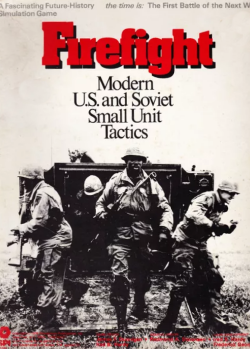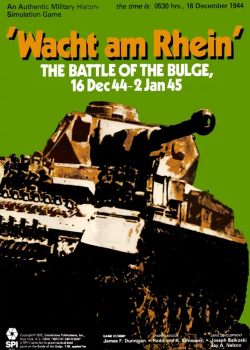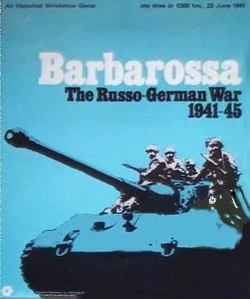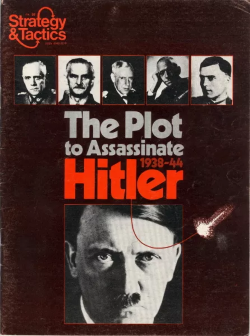
Battle of the Bulge is a board wargame published by Avalon Hill (AH) in 1965 that simulates the World War II battle of the same name. General Anthony McAuliffe (ret.), who had been commanding officer at Bastogne during the Battle of the Bulge, was a consultant during the game's development. The game proved popular and sold more than 120,000 copies, but was dogged by criticisms of historical inaccuracies, and was finally replaced by a completely new edition in 1981. A third edition in 1991 was released as part of the Smithsonian American History Series.

Firefight: Modern U.S. and Soviet Small Unit Tactics is a tactical wargame originally published by Simulations Publications, Inc. (SPI) in 1976 that hypothesizes combat between small units of American and Soviet forces in West Germany in the 1970s.

Wacht am Rhein is a grand tactical monster board wargame published by Simulations Publications, Inc. (SPI) in 1977 that simulates Germany's Battle of the Bulge offensive in late 1944 during World War II.

Narvik: The Campaign in Norway, 1940 is a board wargame published by Game Designers' Workshop (GDW) in 1974 that simulates Operation Weserübung, the German invasion of Denmark and Norway during World War II. The game was one of the first in the Europa series of twenty interlocking games envisioned by GDW that would cover the entire European and North African theatres from the start to the end of World War II, using identical map scales and similar rules.

Kursk, subtitled "History's Greatest Tank Battle, July 1943", is a board wargame published by Simulations Publications Inc. (SPI) in 1980 that simulates the 1943 Battle of Kursk during World War II. The game proved popular, reaching the top of SPI's Bestseller list, and was well received by critics.

Barbarossa: The Russo-German War 1941–45 is a board wargame published by Simulations Publications Inc. (SPI) in 1969 that simulates the conflict between Germany and the Soviet Union on the Eastern Front of World War II. This was only SPI's second game produced during a preliminary round of "Test Series" games, and proved to be the most popular. Despite the title, taken from the German operational name for their initial invasion of the Soviet Union, the game covers the entire Eastern Front campaign from the German invasion in 1941 to the Fall of Berlin in 1945.

'CA': Tactical Naval Warfare in the Pacific, 1941–45 is a board wargame published by Simulations Publications Inc. (SPI) in 1973 that simulates surface naval battles during the Pacific Campaign of the Second World War.

The East Is Red: The Sino Soviet War is a board wargame published by Simulations Publications Inc. (SPI) in 1974 that simulates a hypothetical invasion of Manchuria and North China by Russia using 1970s armaments.

El Alamein: Battles in North Africa, 1942 is a board wargame published by Simulations Publications Inc. (SPI) in 1973 that simulates the final four months of the North African campaign during World War II.

La Grande Armée, subtitled "The Campaigns of Napoleon in Central Europe", is a board wargame published by Simulations Publications Inc. (SPI) in 1972 that simulates three campaigns of Napoleon.

Island War: Four Pacific Battles is a collection of four board wargames published in 1975 by Simulations Publications Inc. (SPI) that simulates various battles between American and Japanese forces during the Pacific Campaign of World War II.

Kursk: Operation Zitadelle is a board wargame published by Simulations Publications Inc. (SPI) in 1971. It was the first wargame to simulate the Battle of Kursk, the large tank battle during World War II.

MechWar '77, subtitled "Tactical Armored Combat in the 1970s", is a board wargame published by Simulations Publications Inc. (SPI) in 1975 that simulates hypothetical tank combat in the mid-1970s between various adversaries, using the same rules system as the previously published Panzer '44.

The Moscow Campaign, subtitled "Strike and Counterstrike Russia", is a board wargame published by Simulations Publications Inc. (SPI) in 1972 that simulates combat near Moscow during World War II.

The Plot to Assassinate Hitler is a board game published by Simulations Publications (SPI) in 1976 that simulates the power struggles in Germany's High Command in the latter years of World War II. The game was the second game in SPI's "Power Politics" series, but did not sell as well as the other games in the series – critic Brian Train referred to it as "the ugly duckling."

East Front is a board wargame published by The Control Box, Inc. in 1976 that simulates combat on the Russo-German Front during World War II. The game had unusual hexagonal-shaped counters rather than the more traditional square counters.

Breakout & Pursuit: The Battle for France, 1944 is a board wargame published by Simulations Publications Inc. (SPI) in 1972 that simulates the breakout of Allied forces from Normandy during World War II, and their subsequent pursuit of retreating German forces.

Von Manstein: Battles for the Ukraine is a board wargame published by Rand Game Associates (RGA) in 1975 that simulates combat in southern Russia and Ukraine during World War II. A revised and expanded version titled Panzerkrieg was released by Operational Studies Group in 1978, and then by Avalon Hill in 1984.

Turning Point: The Battle of Stalingrad is a board wargame published by Simulations Publications Inc. (SPI) in 1972 that simulates the Battle of Stalingrad during World War II, and the factors that led to the encirclement and destruction of Germany's Sixth Army.

The Ardennes Offensive , subtitled "The Battle of the Bulge, December 1944", is a board wargame published by Simulations Publications, Inc. ( in 1973 that simulates the Battle of the Bulge during World War II.




















